Read "DTC Status" parameter.
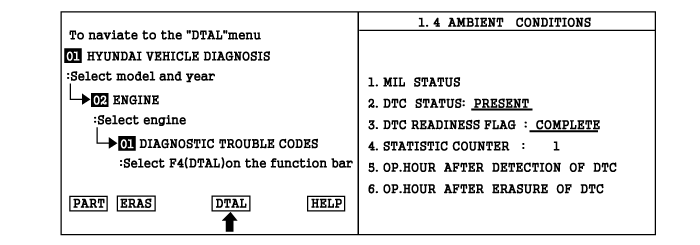
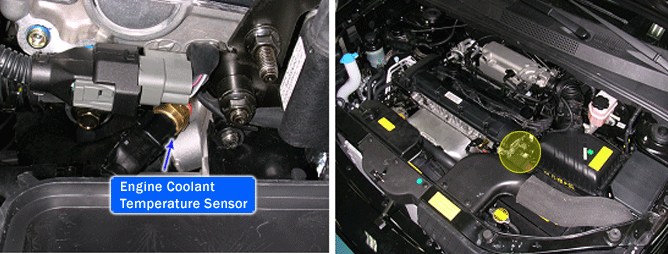
An Engine Coolant Temperature Sensor (ECTS) monitors the temperature of the coolant. This input is used by the PCM for engine control and as an enabling criteria for related diagnostics. The air flow coming into the engine is accumulated and used to determine if the engine has been driven within conditions that would allow the engine coolant to heat up normally to the thermostat regulating temperature. If the coolant temperature does not reach regulating temperature of the thermostat, diagnostics that use engine coolant temperature as enabling criteria, may not run when expected.This DTC will set when there has been excessive time to reach a minimum coolant temperature required for closed loop fuel control.
The purpose of this diagnosis is to monitor the minimum coolant temperature that enables lambda closed loop control after start. Minimum coolant temperature to run lambda control must be reached before the threshold time predetermined according to intake air temperature at start. If the lambda control is not active because of low engine coolant temperature within predetermined minimum time after start, the PCM sets DTC P0125.
Item | Detecting Condition | Possible Cause |
DTC Strategy | ● Check time to closed loop control start with coolant temperature model. | ● Contact resistance in connectors. ● Faulty cooling system. ● Faulty thermostat. ● Faulty ECT sensor. |
Enable Conditions | ● Minimum time after engine start versus intake air temperature at start : 1) 2minutes for intake air temp. > 10℃(50°F) 2) 5minutes for -7℃(19°F) < Intake air temp. < 10℃(50°F) ● 6 < Battery voltage(V) <16 | |
Threshold value | ● Measured coolant temperature < 5°C(41°F) When modeled coolant temperature > 5℃(41°F) | |
Diagonostic Time | ● Immediate. | |
Fall Safe | ● Calculated engine coolant temperature is used for engine control. ● Cooling/Condenser fan is active with MAX speed. ● EVAP. emission control function is controlled in minimum operation mode. |
Temp.(°C) | Temp.(°F) | Resistance(kΩ) |
-20 | -4 | 14.13 ~ 16.83 |
0 | 32 | 5.79 |
20 | 68 | 2.31 ~ 2.59 |
40 | 104 | 1.15 |
60 | 140 | 0.59 |
80 | 176 | 0.32 |
Thermostat | Normal Parameter |
Valve Opening Temp. | 80~84°C(176~183°F) |
Valve Closing Temp. | 77°C(170.6°F) |
Full Open Lift | Above 10mm at 95°C(203°F) |
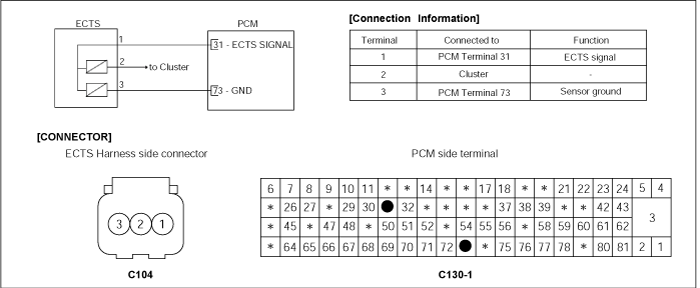
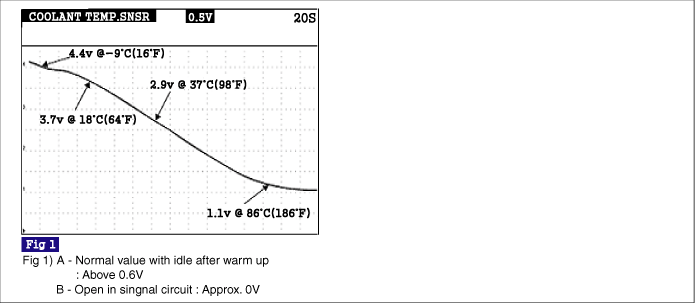
If any codes relating to ECTs are stored, do ALL REPAIRS associated with those codes before proceeding with this troubleshooting.
Connect scan tool and select "Diagnostic Trouble Codes(DTCs)" mode.
Press F4(DTAL) to select DTC information from the DTCs menu.
Confirm that "DTC Readiness Flag" indicates "Complete". If not, drive the vehicle within conditions noted in the freeze frame data or enable conditions.
Read "DTC Status" parameter.

Is parameter displayed "History(Not Present) fault"?
History (Not Present) fault : DTC occurred but has been cleared.
Present fault : DTC is occurring at present time.

▶ Fault is intermittent caused by poor contact in the sensor's and/or PCM's connector or was repaired and PCM memory was not cleared. Thoroughly check connectors for loose or poor connections, bending, corrosion, contamination, deterioration, or damage. Repair or replace as necessary and go to "Verification of Vehicle Repair" procedure.

▶ Go to "Cooling System Inspection" procedure.
Check cooling system coolant level and fill if low.
Check for a proper cooling system operation. Especially check that cooling and condenser fan working normally.
Remove the thermostat and check the following items:
Stuck or damaged
Verify the temperature at which the valve begins to open.
Valve opening temperature : 80~84°C(176~183.2°F)
Valve opening temperature : 95°C(203°F)
is a problem found?

Repair as necessary and go to "Verification of Vehicle Repair" procedure.

Go to next step as below.
Many malfunctions in the electrical system are caused by poor harness(es) and terminals. Faults can also be caused by interference from other electrical systems, and mechanical or chemical damage.
Thoroughly check connectors for looseness, poor connection, bending, corrosion, contamination, deterioration, or damage.
Has a problem been found?

▶ Repair as necessary and go to "Verification of Vehicle Repair" procedure.

▶ Go to "Component Inspection" procedure.
Ignition "OFF" .
Disconnect ECTS connector.
Measure resistance between terminals 1 and 3 of the sensor connector(Component side).
Temp.(°C) | Temp.(°F) | Resistance(kΩ) | Temp.(°C) | Temp.(°F) | Resistance(kΩ) |
-20 | -4 | 14.13~16.83 | 40 | 104 | 1.15 |
0 | 32 | 5.79 | 60 | 140 | 0.59 |
20 | 68 | 2.31~2.59 | 80 | 176 | 0.32 |
Is resistance within the specification?
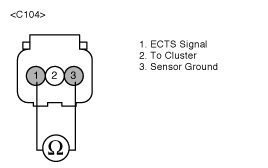

▶ Check for poor connection between PCM and component: backed out terminal, improper mating, broken locks or poor terminal to wire connection. Repair as necessary and go to "Verification of Vehicle Repair" procedure.

▶ Check ECTS for contamination, deterioration, or damage. Substitute with a known-good ECTS and check for proper operation. If the problem is corrected, replace ECTS and then go to "Verification of Vehicle Repair" procedure.
After a repair, it is essential to verify that the fault has been corrected.
Connect scan tool and select "Diagnostic Trouble Codes(DTCs)" mode
Press F4(DTAL) and confirm that "DTC Readiness Flag" indicates "Complete". If not, drive the vehicle within conditions noted in the freeze frame data or enable conditions
Read "DTC Status" parameter
Is parameter displayed "History(Not Present) fault"?

▶ System performing to specification at this time. Clear the DTC

▶ Go to the applicable troubleshooting procedure.